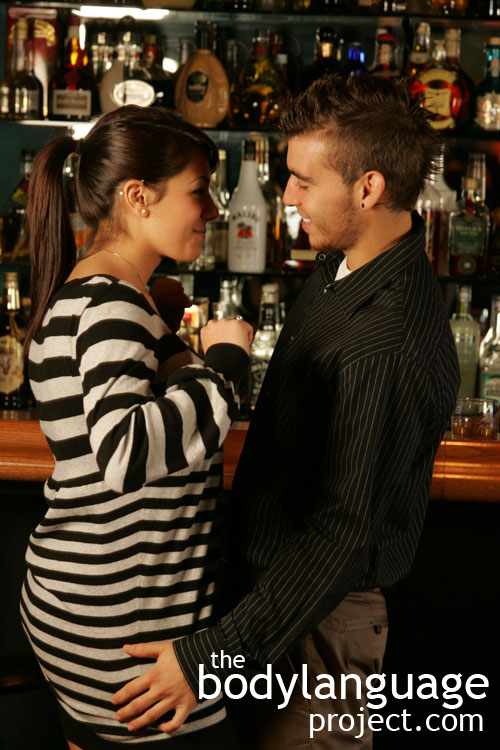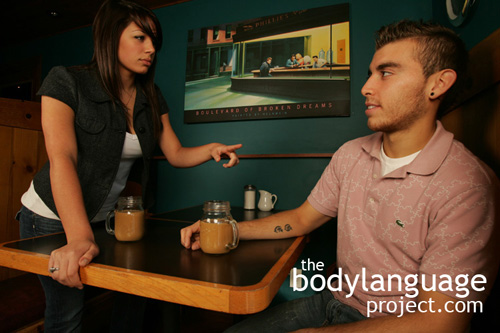Body Language of The Chin Jut and Chin Lift
Synonym(s): Chin Lift, Jutting The Chin, Lifting The Chin, Pushing The Chin Out.
Description: Pushing the chin out and up by slightly tilting the head backwards.
In One Sentence: Jutting the chin out and away from the body tells others that one is ready to confront rather than conform.
How To Use it: Use the signal to show your dominance and to intimidate others. In competition you can use the chin to taunt your opponent and tempt them into submission by demonstrating your pride and smugness. The cue can also be done during normal conversation to issue a challenge of another person’s authority. As the cue is subtle, it is often registered under conscious awareness, but the message will be received as an insult against another person and their position.
Context: General.
Verbal Translation: a) “I’m sticking my chin out to say hello there, I see and acknowledge you.” b) “I’m sticking my chin out to tempt you into punching me and fighting me. It is a challenge as I’m not going to back down.”
Variant: See Chin Stroking, Chin Tuck, Head Lowered.
Cue In Action: a) When passing each other on their bikes, the two riders tilted their chins upward as an acknowledgement. b) It almost came to blows; he stuck his chin out, balled up his first and made threatening remarks.
Meaning and/or Motivation: When the gesture is not done as a greeting or acknowledgement gesture, jutting the chin out means smugness, confidence, pride and confrontation. It is a challenge display, almost like a dare to attack. Lifting the chin exposes the neck to attack but it also puts the chin on full exposure. During physical conflict, a quick jab to the chin often puts people unconscious because it compresses the nerve that runs behind the jaw. Just ask any professional boxer! Keeping the chin tucked, on the other hand, keeps it protected and reduces it as a target making it a submissive posture.
a) A greeting gesture done by quickly forcing the chin outward and returning it to its origin. It is done to acknowledge someone else without having to directly interact with them and done most often by dominant individuals. It signifies superiority, fearlessness and arrogance. b) This is a signal used to display pride, confidence and smugness because it exposes the vulnerable neck to attack. This can be a gesture done subtly as a slight protrusion of the lower jaw.
Cue Cluster: When the chin jut is used in conflict it is accompanied by other threatening language such as balled up fists, arms either lose at the side of the body taunting, or raised and batoning.
Body Language Category: Greeting gesture, Aggressive body language, Anger, Closed facial gestures, Emotional body language, Hostile body language, Negative body language, Power play, Expansive movements, Threat displays, Up nonverbals.
Resources:
Beall, Alec and Jessica L. Tracy. The Puzzling Attractiveness of Male Shame. Manuscript submitted to Evolutionary Psychology. www.epjournal.net – 2014. 12(x): 1-39
http://bodylanguageproject.com/articles/male-nonverbal-shame-attractive/
Bohns, Vanessa K. and Scott S. Wiltermuth. It Hurts When I Do This (Or You Do That): Posture And Pain tolerance. Journal of Experimental Social Psychology. 2012. 48: 341-345.
http://bodylanguageproject.com/articles/dominant-and-submissive-postures-affects-more-than-public-perception-it-also-affects-felt-pain-and-physical-strength/
Conti, Richard P ; Conti, Melanie A. Mock jurors’ perceptions of facial hair on criminal offenders. Perceptual and motor skills. 2004 98:(3 Pt 2): 1356-8
Dixson, Barnaby J ; Tam, Jamie C ; Awasthy, Monica. Do women’s preferences for men’s facial hair change with reproductive status? Behavioral Ecology. 2013 24(3): 708-716.
Dixson, Barnaby J ; Vasey, Paul L. Beards augment perceptions of men’s age, social status, and aggressiveness, but not attractiveness. Behavioral Ecology. 2012. 23(3): 481-490.
De Souza, Altay Alves Lino ; Baião, Vera Baumgarten Ulyssea ; Otta, Emma
Perception of men’s personal qualities and prospect of employment as a function of facial hair. Psychological reports. 2003. 92(1): 201-8.
Grezes, Julie; Le´onor Philip; Michele Chadwick; Guillaume Dezecache; Robert Soussignan and Laurence Conty. Self-Relevance Appraisal Influences Facial Reactions to Emotional Body Expressions. PLoS ONE. 2013. 8(2): e55885. doi:10.1371/journal.pone.0055885
http://bodylanguageproject.com/articles/face-reacts-body-anger-brains-wired-process-emotional-body-language
Gröning, Flora ; Liu, Jia ; Fagan, Michael J ; O’Higgins, Paul. Why do humans have chins? Testing the mechanical significance of modern human symphyseal morphology with finite element analysis. American journal of physical anthropology 2011. 144(4): 593-606.
Hehman, Eric; Jordan B. Leitner and Samuel L. Gaertner. Enhancing Static Facial Features Increases Intimidation. Journal of Experimental Social Psychology. 2013; 49: 747-754.
http://bodylanguageproject.com/articles/tilting-the-head-is-display-of-intimidation-study/
Hall, Judith ; LeBeau, Lavonia ; Reinoso, Jeannette ; Thayer, Frank. Status, Gender, and Nonverbal Behavior in Candid and Posed Photographs: A Study of Conversations Between University Employees. Sex Roles. 2001 44(11): 677-692.
Izard, Carroll E. (1971). The Face of Emotion (New York: Appleton-Century-Crofts).
Johnson, Richard R. and Jasmine L. Aaron. Adults’ Beliefs Regarding Nonverbal Cues Predictive of Violence. Criminal Justice and Behavior. 2013. 40 (8): 881-894. DOI: 10.1177/0093854813475347.
http://bodylanguageproject.com/articles/wanna-fight-nonverbal-cues-believed-indicate-violence
Krumhuber, Eva ; Manstead, Antony ; Kappas, Arvid. Temporal Aspects of Facial Displays in Person and Expression Perception: The Effects of Smile Dynamics, Head-tilt, and Gender. Journal of Nonverbal Behavior. 2007. (1): 39-56
Kret, M. E. and B. de Gelder. When a Smile Becomes a Fist: The Perception of Facial and Bodily Expressions of Emotion in Violent Offenders. Exp Brain Res. 2013. 228: 399-410. DOI 10.1007/s00221-013-3557-6.
http://bodylanguageproject.com/articles/reading-bodily-postures-facial-expressions-incorrectly-can-disastrous-just-ask-violent-offenders/
Li Huang, Adam D. Galinsky, Deborah H Gruenfeld and Lucia E. Guillory. Powerful Postures Versus Powerful Roles: Which Is the Proximate Correlate of Thought and Behavior? 2011, Psychological Science; 22(1): 95–102.
http://bodylanguageproject.com/articles/whats-more-powerful-nonverbal-power-or-real-power/
Martens, Jason P.; Jessica L. Tracy and Azim F. Shariff. Status signals: Adaptive
benefits of displaying and observing the nonverbal expressions of pride and shame, Cognition & Emotion. 2012. 26(3): 390-406. DOI: 10.1080/02699931.2011.645281
http://bodylanguageproject.com/articles/significant-nonverbal-expression-pride-shame-body-language-detailed-examination-origin-function/
Menzel, Charles R. Head-cocking and visual perception in primates. Animal Behaviour. 1980. 28(1): 151-159.
Matsumoto, D., & Willingham, B. (2006). The thrill of victory and the agony of defeat: Spontaneous expressions of medal winners of the 2004 Athens Olympic Games. Journal of Personality and Social Psychology, 91(3), 568–581.
Mouterde, S. C., Duganzich, D. M., Molles, L. E., Helps, S., Helps, R., & Waas, J. R. (2012). Triumph displays inform eavesdropping little blue penguins of new dominance asymmetries. Animal Behaviour, 83, 605–611.
Mignault, Alain and Chaudhuri, Avi. The Many Faces of a Neutral Face: Head Tilt and Perception of Dominance and Emotion. Journal of Nonverbal Behavior. 2003 27(2): 111-132.
Marshall, Steven D. ; Low, Laura E. ; Holton, Nathan E. ; Franciscus, Robert G. ; Frazier, Mike ; Qian, Fang ; Mann, Kyle ; Schneider, Galen ; Scott, Jill E. ; Southard, Thomas E. Chin development as a result of differential jaw growth American Journal of Orthodontics & Dentofacial Orthopedics. 2011 139(4): 456-464.
Middleton, Jacob. Bearded patriarchs: Jacob Middleton investigates the eccentric set of prejudices against shaving that led our Victorian forefathers to adorn their chins with a lush growth of facial hair. History Today. 2006, Vol.56(2), p.26(2).
Neave, Nick and Shields, Kerry. The effects of facial hair manipulation on female perceptions of attractiveness, masculinity, and dominance in male faces. Personality and Individual Differences. 2008 45(5): 373-377.
Nelson, Nicole L. and James A. Russell. Preschoolers’ Use of Dynamic Facial, Bodily, and Vocal Cues to Emotion. Journal of Experimental Child Psychology. 2011; 110: 52-61.
http://bodylanguageproject.com/articles/children-read-body-language-study/
Otta, E., Lira, B. B. P., Delevati, N. M., Cesar, O. P., & Pires, C. S. G. (1994). The effect of smiling and of head tilting on person perception. The Journal of Psychology, 128, 323–331.
Rule, Nicholas, O.; Reginald B. Adams Jr.; Nalini Ambady and Jonathan B. Freeman. Perceptions Of Dominance Following Glimpses Of Faces And Bodies. Perception. 2012; 41: 687-706 doi:10.1068/p7023
http://bodylanguageproject.com/articles/people-can-read-dominance-split-second
Stienen, Bernard M. C.; Akihiro Tanaka and Beatrice de Gelder. Emotional Voice and Emotional Body Postures Influence Each Other Independently of Visual Awareness. PLoS ONE. 2011. 6(10): e25517. doi:10.1371/journal.pone.0025517.
http://bodylanguageproject.com/articles/body-language-read-quickly-subconsciously-study/
Schubert, T. W. (2005). Your highness: Vertical positions as perceptual symbols of power. Journal of Personality and Social Psychology. 89, 1–21.
Tracy, Jessica L. and Richard W. Robins. The Nonverbal Expression of Pride: Evidence for Cross-Cultural Recognition. Journal of Personality and Social Psychology. 2008. 94(3): 516–530. DOI: 10.1037/0022-3514.94.3.516
http://bodylanguageproject.com/articles/nonverbal-expression-pride-recognized-cross-culturally/
Tracy, J. L., & Matsumoto, D. (2008). The spontaneous expression of pride and shame: Evidence for biologically innate nonverbal displays. Proceedings from the National Academy of Sciences, 105(33), 11655–11660.
Tracy, J. L., & Robins, R. W. (2007). The prototypical pride expression: Development of a nonverbal behavior coding system. Emotion, 7(4), 789–801.
Welker, Keith M.; Stefan M.M.; Goetz, Shyneth Galicia; Jordan Liphardt and Justin M. Carré. An Examination of the Associations Between Facial Structure, Aggressive Behavior, and Performance in the 2010 World Cup Association Football Players. Adaptive Human Behavior and Physiology (forthcoming in print, online July).
http://bodylanguageproject.com/articles/facial-width-predicts-strength-soccer-field
Weisbuch, Max ; Slepian, Michael L ; Eccleston, Collette P ; Ambady, Nalini. Nonverbal Expressions of Status and System Legitimacy. Psychological Science. 2013. 24(11): 2315-2321.
Wogalter, Michaels. ; Hosie, Juditha. Effects of Cranial and Facial Hair on Perceptions of Age and Person. The Journal of Social Psychology. 1991 131(4): 589-591.







